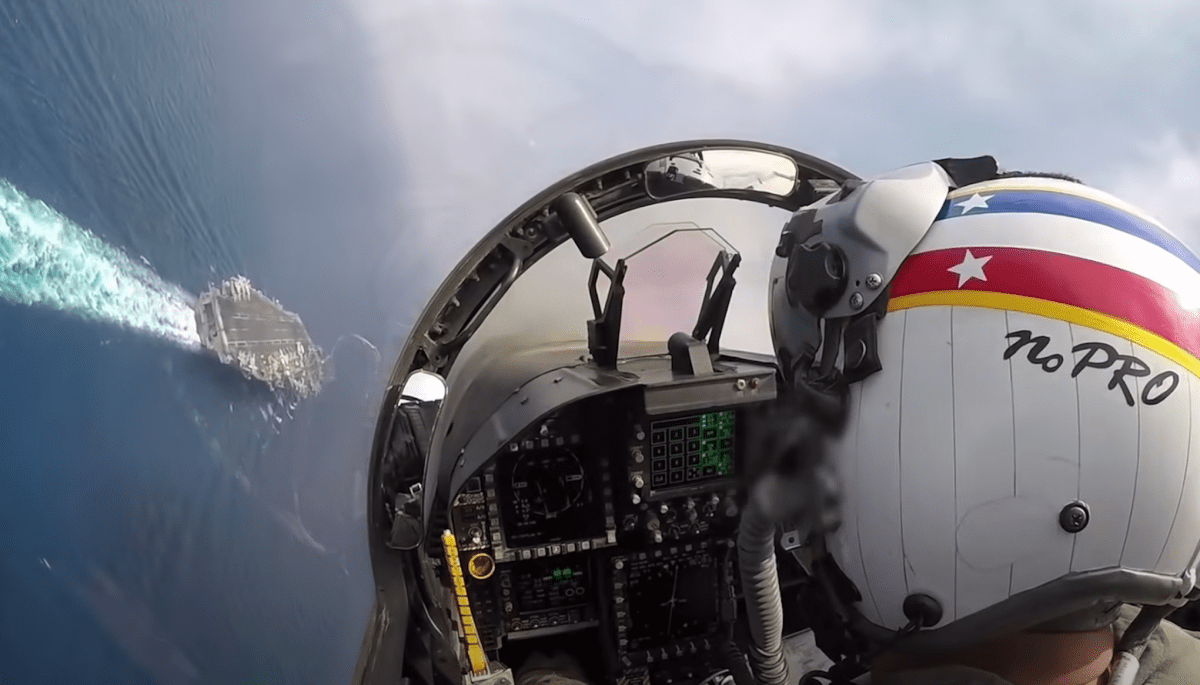[ad_1]
It’s your first carrier night landing, and you’ve called the ball.
Your knees are shaking, because you’re scared sh–less.
Inside your helmet, you’re sweating profusely, as the moment of truth approaches.
The worst mistake, and probably a fatal one, is to come in too low or too slow. That leaves the you short of the runway, making it almost certain that the plane will slam into the ship.
You don’t even have time for the pilots’ prayer; “Please god, don’t let me f–k up.â€
You shift your eyes from the glowing green panel in the cockpit and lock onto a bright ray of light beamed from the carrier deck.
The light, called a “meatball†because of its shape, warns the aviator if he is too high or low.
A carrier pilot makes an average of about 300 minor adjustments during the final 18 seconds on approach – having to balance how fast the aircraft is going, whether it’s on the right glide slope to land on a pitching carrier deck, and whether it is properly positioned laterally.
It’s white knuckles all the way, as you hit the deck, and hope to catch one of the four cables, which are only 40 feet apart — all the while, preparing to become airborne again, if you miss.
This is the awful terror a US Navy pilot experiences, as he makes his first foray into night carrier landings — the most dangerous thing you can do, in all of aviation.
So fearsome is are carrier landings, that US pilots in the Vietnam war said they didn’t fear SAM missiles or being shot down — it was the knowledge that they would have to set it back down on a carrier after their gruelling 6-hour mission.
However, thanks to a new software tool, dubbed “Precision Landing Mode†that is added to the jet’s flight control and mission computers, the number of inputs a pilot has to make in those final seconds is drastically reduced, USNI News reported.
Capt. Dan Catlin, the commanding officer of Strike Fighter Squadron VFA 106, this week brought some newly winged pilots out to USS Gerard R. Ford (CVN-78) to conduct their first landings at sea in an F-/A-18E-F Super Hornet, both in the daylight and at night.
“I will say that, without a doubt, hands down, Day 1 yesterday was by far the smoothest evolution, best performance we’ve seen from our students ever – and that’s by an awful lot,†said Catlin, who personally oversees all his students’ carrier qualifications.
“You’ll see the white knuckles, the shaky knees, and you can see the expression on the face of somebody who’s just landed on an aircraft carrier at night for the first time – we didn’t see that last night,†Catlin told reporters in a call while aboard Ford.
“What we saw was a lot of confident aviators who realized that technology is really making something that was supposed to be incredibly hard actually a little bit of fun – not a lot of fun, flying at night is never anyone’s first choice – but the expression on their face really told the story of what this capability brings. They were confident, and quite frankly I think they had a good time out there.â€
With PLM, says Catlin, the number of minor throttle adjustments has been reduced from the hundreds, down to single digits, USNI News reported.
The pilot manually inputs the ship’s speed, and then the PLM system automatically computes the proper 3.5-degree glide slope for a safe landing. Once a pilot gets on the ball – not coming in too high or low – the PLM system locks in and maintains that trajectory by managing the throttle.
“What that allows the pilot to do, especially a young, inexperienced pilot, is spend a lot more time focusing on the scan of where that pilot is on the glide slope and where they are on lineup,†Catlin said.
“It’s no small feat to land on an aircraft carrier at night, with a pitching deck, and after a long six-and-a-half-hour-long combat mission. It’s an incredibly dangerous evolution,†he continued. “What PLM allows us to do is to make that evolution much, much more safe and more efficient.â€
Capt. J.J. Cummings, Ford’s commanding officer, said on the call that he had used PLM for about 20 landings himself and was amazed at how few changes he had to make with the stick while coming in for a landing, USNI News reported.
“The precision landing mode, it’s been eye-watering to watch [newly winged pilots] go behind the boat, day and night,†he said.
The young aviators made about 40 passes on Sunday, he said, with just a small number who bolter – when the landing gear hits the flight deck but doesn’t latch onto the arresting gear to stop the plane – and just a few were called by the landing signal officers to make adjustments on their approach.
“I recall one student, his first night trap ever in F-18 Super Hornet, he flew what’s called a rails pass: basically essentially a perfect pass to what’s called an OK 2 wire for his first trap at night in a Super Hornet, and it was staggering to observe,†Cummings said.
“This PLM system is amazing for the stability that it provides the aircraft on glide path, and we’ll see increased boarding rates for these aviators and then get folks to the fleet sooner, because generally you have about 5 percent of the fleet replacement pilots will disqualify because of boarding rate or lane performance. With PLM, we’re going to see that number drop significantly and possibly to zero.â€
— With files from LA Times
[ad_2]
Source link













